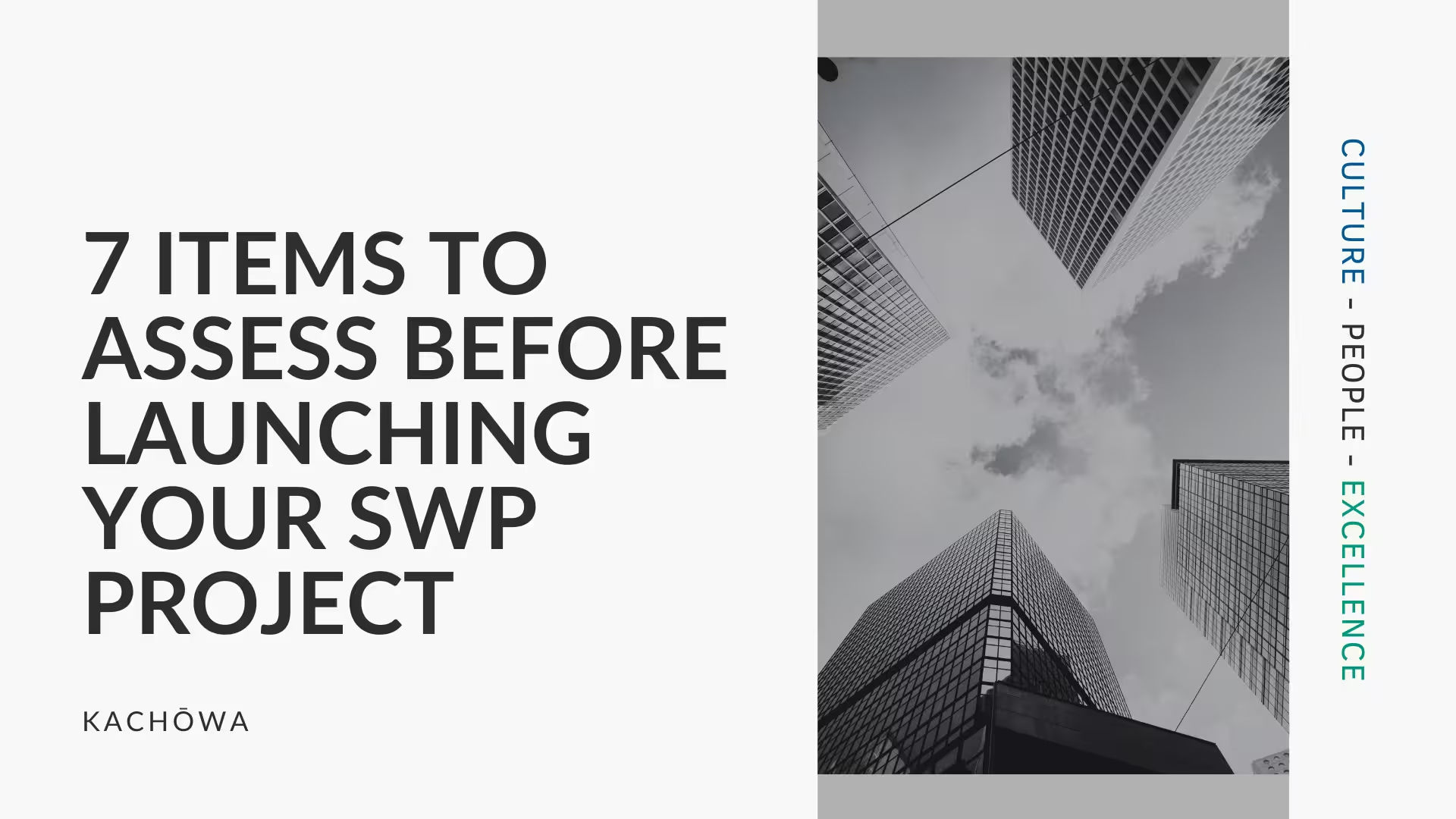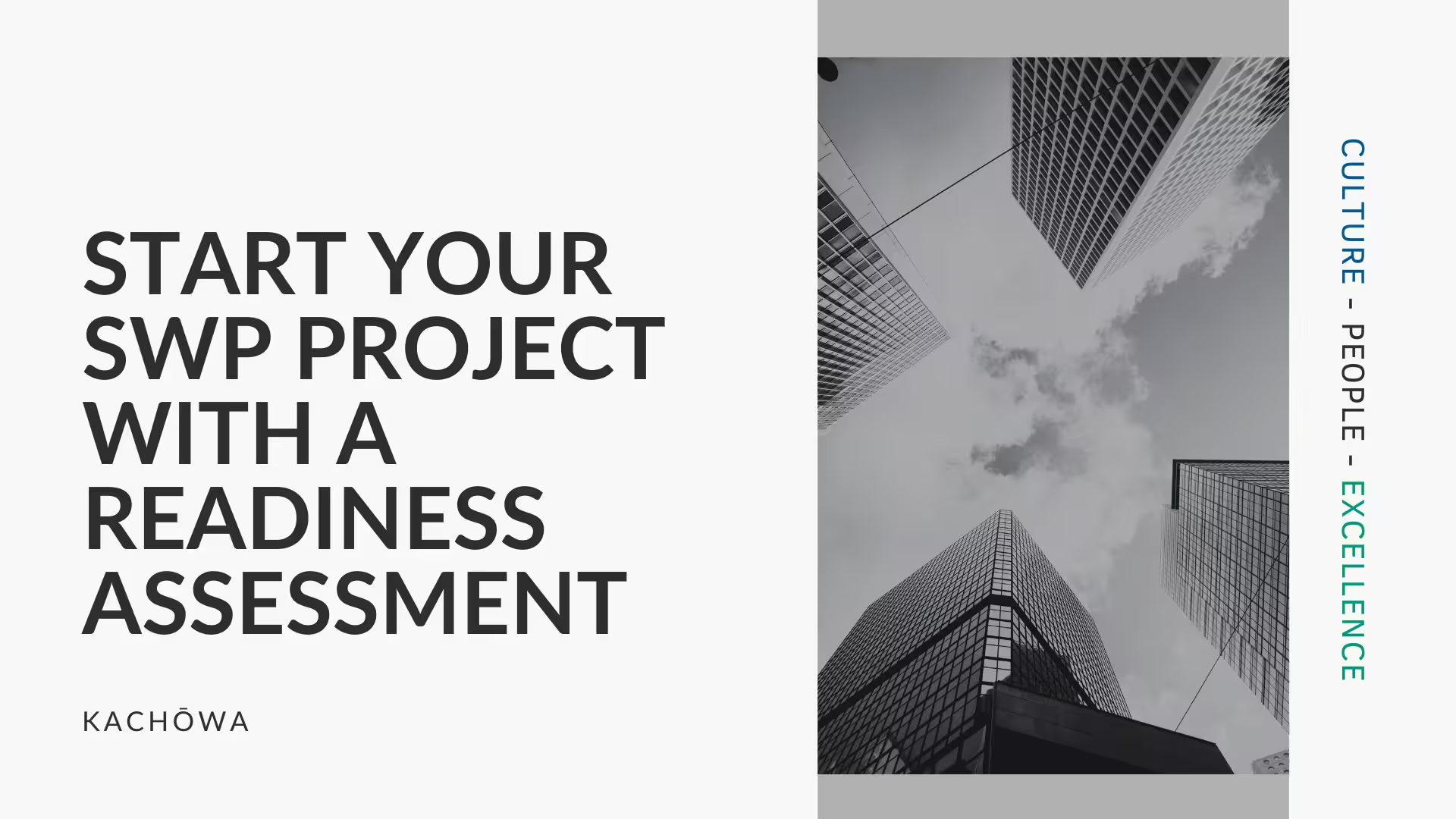
7 items to assess before launching your SWP project
In summary, what you need to remember from this article …
✦ The SWP Readiness Assessment is an important stage in the preparation of a Strategic Workforce Planning (SWP) project. It aims to lay the foundations for the project by identifying the issues, the potential impacts on the organisation, the risks, and by aligning the company’s objectives with the necessary resources.
✦ The SWP Readiness Assessment is made up of 7 key items covering essential areas such as corporate culture, SWP challenges, sponsorship and resources, corporate strategy, employee skills, tools and analytics, as well as the risks and consequences of the project on the organisation.
✦ Completing the SWP Readiness Assessment can generate concrete actions to put in place before embarking on a SWP project, thus guaranteeing the success of the initiative. This questioning phase helps to anticipate future changes, identify areas requiring particular attention, and maximise the SWP project’s chances of success.
In the last article I published, which explained the preparation phase of a SWP project, I explained how important it was to start a SWP project with a questioning phase in order to be as prepared as possible for the launch of the project, or to readjust the route if the project had not got off on the right foot…
If you’ve read the whole of this article, you’ll have realised that … I didn’t really go into the content of this questioning and in particular the different items that make up the SWP Readiness Assessment tool.
Guess what? That’s what I’d like to take a look at together in this blog post!
Please note: this is a phase where you’ll be asking yourself lots of questions, and that’s normal. The aim of this phase is :
- to become aware of the issues at stake and the potential impact of a SWP project on your operations,
- Identify potential risks and prepare risk mitigation strategies,
- align the company’s objectives with the necessary resources, thereby strengthening the coherence of the actions undertaken,
- prepare the ground for change by engaging stakeholders and identifying future challenges.
And to do this, we need to question the main elements that make up a SWP project! And there are 7 main elements.
The SWP Readiness Assessment tool, which summarises this questioning phase, is made up of 7 key items which will cover a wide range of areas essential to the success of your project. For each of these items, you will find a series of questions which have been designed to encourage you to take the time to reflect on the potential challenges and repercussions that your project could have on your organisation.
Completing this document can be a project in itself if you are starting from scratch and new to Strategic Workforce Planning. Indeed, it can generate concrete actions that should be implemented before you embark on a SWP project and to ensure its success.
And that’s exactly what this tool is all about!
The aim is to ensure that you have all the elements you need to roll out your project in the best possible conditions.
The aim of this questioning phase is therefore to help you anticipate and prepare your organisation for the changes to come, while identifying the areas that require particular attention. By answering these questions in depth, you will be better equipped to make decisions and ensure that your project is aligned with your organisation’s objectives and needs, while maximising its chances of success.
And if you ever feel stuck or have other questions that emerge following your brainstorming, remember that I’m here to support you in this questioning phase.
Now I’d like to take a closer look at the 7 items assessed in this Readiness Assessment.
The 7 items of the SWP Readiness Assessment
The 7 items of this Readiness Assessment will cover the following themes:
- Corporate culture: Assessing the corporate culture is essential to understanding how the SWP will be received. The aim is to determine whether the culture encourages adaptation to change, collaboration and transparency, all of which are crucial to the success of the SWP.
- The challenges of a SWP and its impact on your organisation: Understanding the specific challenges of a SWP and its potential impact on the organisation is fundamental. This enables you to anticipate the challenges and prepare the stakeholders for this transformation process.
- Sponsorship and key resources : Identifying the project sponsors and the key resources required to implement the SWP is important. This guarantees high-level support and the resources needed to succeed.
- Corporate strategy: Ensuring that the SWP is aligned with the overall corporate strategy is essential. This ensures that efforts are directed towards the organisation’s strategic objectives.
- Employee skills : Assessing the current skills of employees is a central element of the SWP. This helps to identify skills gaps and develop appropriate HR action plans.
- The tools and analytics that will be used: Identifying the tools and analysis systems that will be used as part of the SWP is important to ensure effective data collection and relevant analysis.
- The risks and consequences of the project on your organisation: Examining the potential risks of the SWP and the consequences for the organisation if problems arise is an important step. This enables risk reduction strategies to be devised and plans to be made accordingly.
In summary, these 7 items will cover 4 essential areas of any transformation project, whether it’s an internal reorganisation, adoption of new technologies, business expansion or any other major initiative : People, Processes, Resources and Organisation. These four elements form an integrated framework to ensure the success of your transformation.
When embarking on a transformation project, each of these aspects is interconnected and ignoring any one of these areas can lead to major challenges. For example, reorganising without taking into account employee training and commitment can lead to increased resistance to change. Similarly, automating processes without properly managing financial resources can be costly and ineffective.
Successful transformation requires a holistic approach, taking all these aspects into account. By integrating these areas into your transformation strategy, and more specifically into your SWP project, you can maximise your company’s chances of success and sustainable growth.
And don’t forget that, over and above a simple assessment, working on these 7 items will make it easier for you to get your stakeholders and employees on board during the SWP implementation phase.
If we take, for example, the context of the company, asking questions about the company’s vision or strategy will not only enable you to take better ownership of the issues at stake, but also to challenge the company’s strategy. And what’s more … have you identified different scenarios in relation to this strategy?
What’s more, you’ll find it easier to get everyone in the company on board if you’re able to communicate regularly about this strategy and its implementation in each department of the company.
Another example: by developing a better understanding of your employees through the skills they have acquired throughout their professional and personal experience, this will enable you to better connect the future needs of your company with the capabilities of your employees, while building loyalty. This knowledge of skills will also be useful in other HR processes and will help you in your skills development and employee engagement initiatives.
The key stages of this Readiness Assessment
1- Identify the key players in the project
Ideally, it would be a good idea to complete the SWP Readiness Assessment with the team who will be responsible for working on the SWP. This will give you an initial idea of everyone’s perception of the subject before the work actually gets underway (and you won’t feel so alone in this exercise).
Try to identify the key stakeholders – preferably both in the business, finance and human resources departments – and make sure you have their support before launching the project. A good exercise is to go to them with this template and ask their opinion on the company’s position with regard to the Readiness Assessment items.
2- Collect the information you need to understand and analyse the project
An important step in any SWP project is to gather relevant information about the organisation, its current workforce, its human resources management practices, its corporate culture, its strategic objectives, and so on. You may need to conduct interviews with HR managers, senior executives and other stakeholders to gather this information.
3- Analyse the data collected
An in-depth analysis of the data collected will enable you to assess your company’s readiness to embark on a SWP project.
The data to be collected could include, for example, the availability of information on employee skills, information on the company’s culture and strategy, etc.
4- Write the analysis report
Once you have collected and analysed the data needed to complete the SWP Readiness Assessment, complete the template and write a full report summarising the results of this self-assessment that you can share with your sponsors and stakeholders.
Highlight the organisation’s SWP strengths and weaknesses. Propose specific recommendations to strengthen the organisation’s preparedness.
These recommendations may include a request to strengthen the project team (using internal or external resources), investment in employee skills management systems, changes to the organisational culture, etc.
The report and recommendations must also take into account the need for constant evolution and continuous improvement of the process. The aim is not to get 100% on all items, but rather to become aware of the points on which you will need to pay closer attention in order to ensure the success of your deployment.
5- Share the results of the report
We sometimes forget this, but remember that this report is not an end in itself. Share the results and your recommendations with the key players in the project and discuss the measures to be implemented to ensure the success of your project.
And remember that Strategic Workforce Planning is an ongoing process. Although your company may not be fully ready at the outset, it can gradually develop its capabilities over time. And it will be essential to monitor progress regularly, making adjustments where necessary and optimising ongoing actions throughout the deployment phase.
The aim is not to be 100% on all items, but rather to be aware of the company’s starting point, i.e. the “height of the step to be taken” and the potential difficulties you will encounter throughout the roll-out of this project.
In the next article, I’ll show you how to implement the results of this SWP Readiness Assessment and move forward with the launch of your SWP project within your organisation. Once you have completed this assessment of your company, you will have a solid basis for defining the next stages of your SWP project.

If you would like me to help you during the launch phase of your SWP project, please contact me so that we can discuss it together.




Leave a Reply